2017--2018学年人教版必修二Unit 4 Wildlife protection reading教案
- 格式:docx
- 大小:178.12 KB
- 文档页数:4


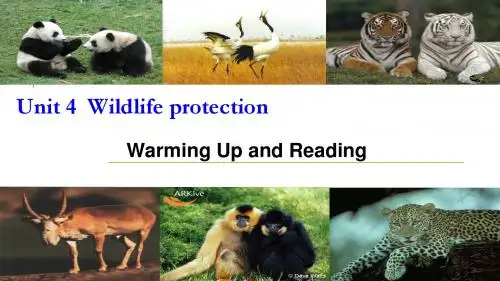
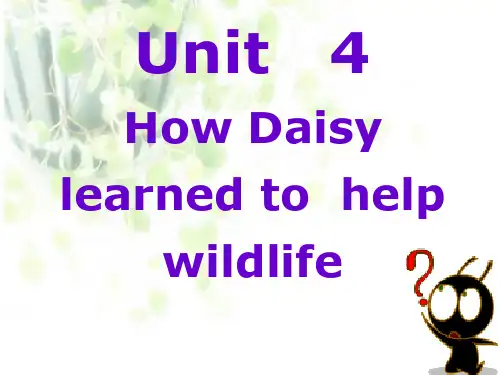

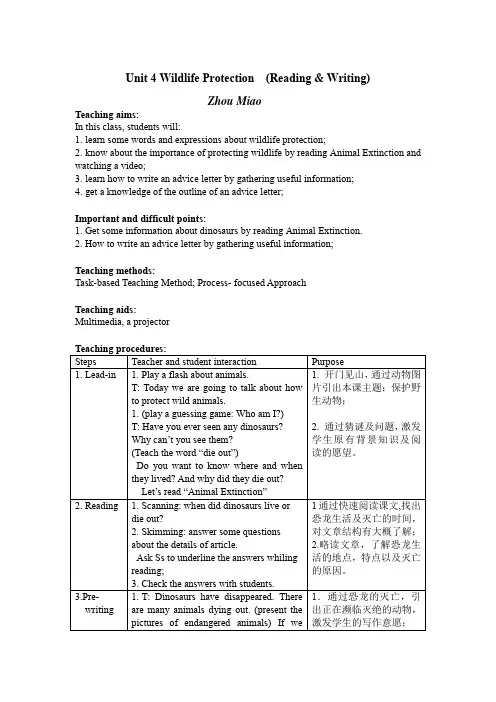
Unit 4 Wildlife Protection (Reading & Writing)Zhou MiaoTeaching aims:In this class, students will:1.learn some words and expressions about wildlife protection;2.know about the importance of protecting wildlife by reading Animal Extinction and watching a video;3.learn how to write an advice letter by gathering useful information;4.get a knowledge of the outline of an advice letter;Important and difficult points:1. Get some information about dinosaurs by reading Animal Extinction.2. How to write an advice letter by gathering useful information;Teaching methods:Task-based Teaching Method; Process- focused ApproachTeaching aids:Multimedia, a projectorTeaching procedures:Steps Teacher and student interaction Purpose1. Lead-in 1. Play a flash about animals.T: Today we are going to talk about howto protect wild animals.1.(play a guessing game: Who am I?)T: Have you ever seen any dinosaurs?Why can’t you see them?(Teach the word “die out”)Do you want to know where and whenthey lived? And why did they die out?Let’s read “Animal Extinction”1. 开门见山,通过动物图片引出本课主题:保护野生动物;2. 通过猜谜及问题,激发学生原有背景知识及阅读的愿望。
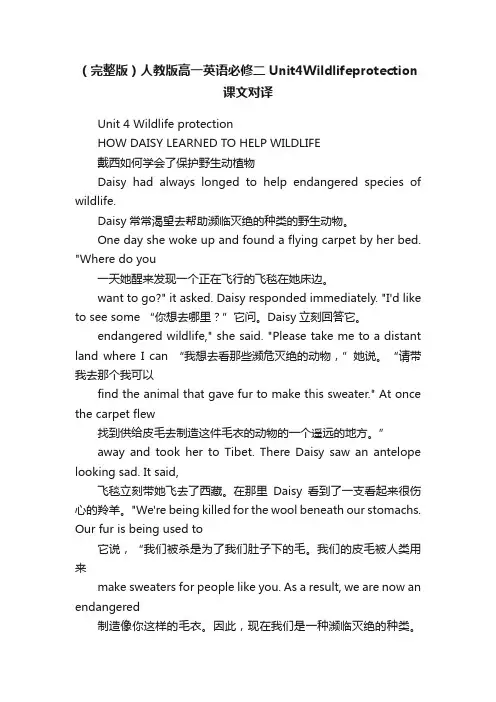
(完整版)人教版高一英语必修二Unit4Wildlifeprotection课文对译Unit 4 Wildlife protectionHOW DAISY LEARNED TO HELP WILDLIFE戴西如何学会了保护野生动植物Daisy had always longed to help endangered species of wildlife.Daisy常常渴望去帮助濒临灭绝的种类的野生动物。
One day she woke up and found a flying carpet by her bed. "Where do you一天她醒来发现一个正在飞行的飞毯在她床边。
want to go?" it asked. Daisy responded immediately. "I'd like to see some “你想去哪里?”它问。
Daisy立刻回答它。
endangered wildlife," she said. "Please take me to a distant land where I can “我想去看那些濒危灭绝的动物,”她说。
“请带我去那个我可以find the animal that gave fur to make this sweater." At once the carpet flew找到供给皮毛去制造这件毛衣的动物的一个遥远的地方。
”away and took her to Tibet. There Daisy saw an antelope looking sad. It said,飞毯立刻带她飞去了西藏。
在那里Daisy看到了一支看起来很伤心的羚羊。
"We're being killed for the wool beneath our stomachs. Our fur is being used to它说,“我们被杀是为了我们肚子下的毛。
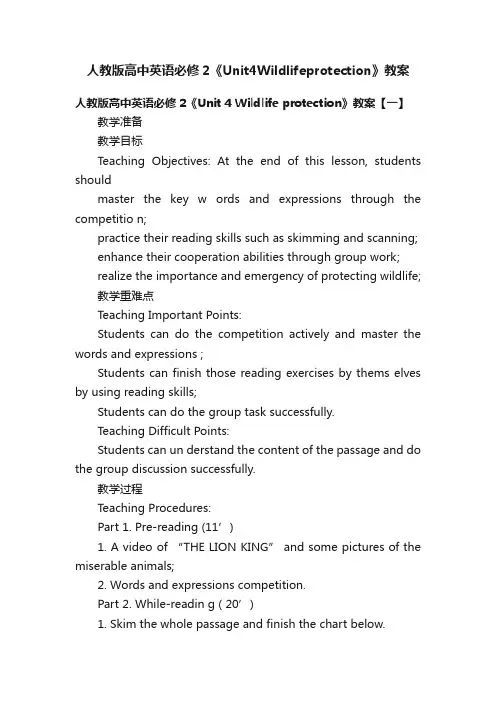
人教版高中英语必修2《Unit4Wildlifeprotection》教案人教版高中英语必修2《Unit 4 Wildlife protection》教案【一】教学准备教学目标Teaching Objectives: At the end of this lesson, students shouldmaster the key w ords and expressions through the competitio n;practice their reading skills such as skimming and scanning;enhance their cooperation abilities through group work;realize the importance and emergency of protecting wildlife;教学重难点Teaching Important Points:Students can do the competition actively and master the words and expressions ;Students can finish those reading exercises by thems elves by using reading skills;Students can do the group task successfully.Teaching Difficult Points:Students can un derstand the content of the passage and do the group discussion successfully.教学过程Teaching Procedures:Part 1. Pre-reading (11’)1. A video of “THE LION KING” and some pictures of the miserable animals;2. Words and expressions competition.Part 2. While-readin g ( 20’)1. Skim the whole passage and finish the chart below.2. Read the Paragraph 1 and find out the answers to the following questions.1). How did the antelope feel?2). Why are people hunting and killing the Tibetan antelopes?3. Read paragraph 2 and choose the best answer according to the text.1). Why is the number of elephants increa sing in Zimbabwe?A. Because more elephants have come to Zimbabwe.B. Because farmers are happy and no longer kill them;C, Because those elephants don’t destroy farms any more.2). How does the government of Zimbabwe help protec t wild animals?A. It allowed tourists to hunt a small number of animals if they paid the farmers;B. It forced farmers to protect the animals.C. It put m ore wild animals into Zimbabwe.4. Read parag raph 3 and fill in the blanks.When the carpet and Daisy came to ___ ___ ______, they saw a _______ rubbing itself with a millipede _______, which can ______ mosquitoes because it ______ a powerful drug. The money told Daisy to pay more ________to the rainforest and _____ how the animals live t ogether. No forest, no animals, no _____.5. True or False statements.1. Daisy saw many antelopes in Tibet.2. Daisy’s sweater was made of sheep wool.3. The elephant used to be well protected in Zimbabwe.4. In Zimbabwe, tourists love to see the elephants.5. The farmers in Zimbabwe get nothing from the elephants now.6. This is a real story in Daisy’s life.Part 3. Post-reading ( 8’)1.Ask “Daisy” to talk about her feeling;2. Discussion: What should we do to protect wildlife?3. See a short video of Jackie Chan.Part 4. Summary and Wri ting ( 1’)Write a short passage based on the discussion.课后习题Please write a letter to WWF and provide some suggestions on how to protect wildlife.人教版高中英语必修2《Unit 4 Wildlife protection》教案【二】教学准备教学目标Improve students’ ability of extensive reading.Improve students’ a skills of listening.教学重难点1. Teaching important points:A. Improve students’ ability of extensive reading.B. Improve students’ a skills of listening.2. Teaching difficult points:A. How to finish the task in limited time.B. How to get the accurate information while listening.教学工具课件教学过程Step 1. GreetingStep 2. Daily reportStep 3. RevisionCheck the answers to the exercises done yesterday.Step 4. Extensive reading1. Ask students two questions before listening to the tape,and then listen to the recording of the text:A. When did dinosaurs live on the earth?B. Why did they die out?2. Explain the following language points:① long before 很久以前before long 不久之后Dinosaurs do live on the earth long before.Before long dinosaurs die out from the earth.② on the earth- in the worldon earth 究竟What on earth do you want?Step 5. Listening1. Explain the following difficult words to the students before listening:① o nce upon a time 曾经;很久以前② curious adj. 好奇的③ wing n. 翅膀④ trap n. 陷阱⑤ spear n. 矛2. Listen to the recording of Dodo’s Story.3. Finish Ex 1 on p30.4. Check the answers (C D B C)5. Listen to the tape again and finish ex2 on P30Step 6 Homework1. Finish Ex. 21-55 on English Weekly 15th2. Review the language points in this unit.课后小结学了这节课,你有什么收获?课后习题完成课后习题。

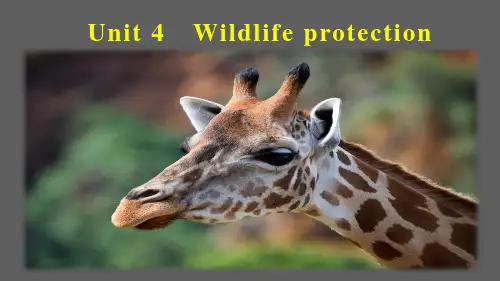

Unit 4 Wildlife protectionHOW DAISY LEARNED TO HELP WILDLIFE戴西如何学会了保护野生动植物Daisy had always longed to help endangered species of wildlife.Daisy常常渴望去帮助濒临灭绝的种类的野生动物。
One day she woke up and found a flying carpet by her bed. "Where do you一天她醒来发现一个正在飞行的飞毯在她床边。
want to go?" it asked. Daisy responded immediately. "I'd like to see some “你想去哪里?”它问。
Daisy立刻回答它。
endangered wildlife," she said. "Please take me to a distant land where I can “我想去看那些濒危灭绝的动物,”她说。
“请带我去那个我可以find the animal that gave fur to make this sweater." At once the carpet flew找到供给皮毛去制造这件毛衣的动物的一个遥远的地方。
”away and took her to Tibet. There Daisy saw an antelope looking sad. It said,飞毯立刻带她飞去了西藏。
在那里Daisy看到了一支看起来很伤心的羚羊。
"We're being killed for the wool beneath our stomachs. Our fur is being used to它说,“我们被杀是为了我们肚子下的毛。
Unit4Wildlife protectionHOW DAISY LEARNED TO HELP WLDLIFEDaisy had always longed to help endangered species of wildlife.One day she woke up and found a flying carpet by her bed."Where do you want to go?"it asked.Daisy responded immediately."I'd like to see some endangered wildlife,"she said. "Please take me to a distant land where I can find the animal that gave fur to make this sweater."At once the carpet flew a way and took her to Tibet.There Daisy saw an antelope looking sad.It said,"We're being killed for the wool beneath our stomachs.Our fur is being used to make sweaters for people like you.As a result,we are now an endangered species."At that Daisy cried,"I'm sorry I didn't know that.I wonder what is being done to help you.Flying carpet,please show me a place where there's some wildlife protection."The flying carpet travelled so fast that next minute they were in Zimbabwe.Daisy turned around and found that she was being watched by an elephant."Have you come to take my photo?"it asked.In relief Daisy burst into laughter."Don't laugh ,”said the elephant,"We used to be an endangered species.Farmers hunted us without mercy.They said we destroyed the ir farms,and money from tourists only went to the large tour companies.So the government decided to help.They allowe d tourists to hunt only a certain number of animals if they paid the farmers.Now the farmers are happy and our numbers are increasing.So good things are being done here to save local wildlife."Daisy smiled."That's good news.It shows the importance of wildlife protection,but I'd like to help as the WWF suggests. "The carpet rose again and almost at once they were in a thick rainforest.A monkey watched them as it rubbed itself."What are you doing?"asked Daisy.”I’m protecting myself from mosquitoes,"it replied."When I find a millipede insect,I rub it over my body.It contains a powerful drug which affects mosquitoes.You should pay more attention to the rainforest where I live and appreciate how the animals live together.No rainforest,no animals,no drugs."Daisy was amazed."Flying carpet,please take me home so I can tell WWF and we can begin producing this new drug. Monkey,please come and help."The monkey agreed.The carpet flew home.As they landed,things began to disappear. Two minutes later everything had gone - the monkey,too.So Daisy was not able to make her new drug.But what an experience!She had learned so much!And there was always WWF…Book2Unit4wildlife/'waɪldlaɪf/n.野生动植物protection/prə'tekʃn/n.保护wild/waɪld/adj.野生的;野的;未开发的;荒凉的△habitat/'hæbɪtæt/n.栖息地(动植物的)自然环境△threaten/'θretən/vt.&vi.恐吓;威胁decrease/dɪ'kri:s/vi.&vt.减少;(使)变小;或变少△endanger/ɪn'deɪndʒə/vt.危害;使受到危险die out灭亡;逐渐消失loss/lɒs/n.损失;遗失;丧失reserve/rɪ'zɜ:v/n.保护区hunt/hʌnt/vt.&vi.打猎;猎取;搜寻zone/zəʊn/n.地域;地带;地区in peace和平地;和睦地;安详地in danger(of)在危险中;垂危△Daisy/'deɪzɪ/n.戴茜(女名)△species/'spi:ʃɪ:z/n.种类;物种carpet/'kɑ:pɪt/n.地毯respond/rɪ'spɒnd/vi.回答;响应;做出反应distant/'dɪstənt/adj.远的;远处的fur/fɜ:/n.毛皮;毛;软毛△antelope/'æntɪləʊp/n.羚羊△Zimbabwe/zɪm'ba:bweɪ/n.津巴布韦(非洲东南部国家)relief/rɪ'li:f/n.(痛苦或忧虑的)减轻或解除;减轻痛苦的事物in relief如释重负;松了口气laughter/'lɑ:ftə/n.笑;笑声burst into laughter突然笑起来;大声笑了出来mercy/'mɜ:sɪ/n.仁慈;宽恕;怜悯certain/'sɜ:tn/adj.确定的;某一;一定importance/ɪm'pɔ:təns/n.重要(性)△WWF(World Wildlife Fund)世界野生生物基金会rub/rʌb/vt.擦;摩擦protect…from保护……不受……(危害)mosquito/mə'ski:təʊ/n.蚊子△millipede/'mɪlɪpi:d/n.(=millepede)千足虫insect/'ɪnsekt/n.昆虫contain/kən'teɪn/vt.包含;容纳;容忍powerful/'paʊəfl/adj.强大的;有力的affect/ə'fekt/vt.影响;感动;侵袭attention/ə'tenʃn/n.注意;关注;注意力pay attention to注意appreciate/ə'pri:ʃɪeɪt/vt.鉴赏;感激;意识到succeed/sək'si:d/vi.成功vt.接替;继任△Indonesia/ɪndəʊ'ni:ʒə;-zɪə/n.印度尼西亚(东南亚岛国)△rhino/'raɪnəʊ/n.犀牛secure/sɪ'kjʊə/adj.安全的;可靠的income/'ɪŋkʌm;'ɪnkʌm/n.收入employ/ɪm'plɔɪ/vt.雇用;利用(时间、精力等)harm/hɑ:m/n.&vt.损害;危害△Milu deer麋鹿bite/baɪt/vt.&vi.(bit,bitten)咬;叮;刺痛△extinction/ɪk'stɪŋkʃn/n.灭绝;消亡dinosaur/'daɪnəsɔ:/n.恐龙come into being形成;产生△county/'kaʊntɪ/n.县;郡inspect/ɪn'spekt/vt.检查;视察△unexpected/ʌnɪk'spektɪd/adj.没料到的;意外的incident/'ɪnsɪdənt/n.事件;事变dust/dʌst/n.灰尘;尘土;尘埃according to按照;根据……所说△Mauritius/mə'rɪʃəs/n.毛里求斯(非洲东部岛国)△disappearance/dɪsə'pɪərəns/n.消失fierce/fɪəs/adj.凶猛的;猛烈的so that以致于;结果ending/'endɪŋ/n.结局;结尾△faithfully/'feɪθfəlɪ/adv.忠诚地;忠实地△Colobus/'kɒləbəs/monkey(非洲产)疣猴,髯猴II---IV Wildlife protection单项选择1. It seemed that he was______ losing his life. Luckily, he was______ in the end.A. in the danger of; out of dangerB. in danger of; out of danger;C. in the danger; out of the danger;D. in danger of ; out of the danger;2. More attention should be ___ equipment in our factory so that we can increase our productionA. paid to improving; B paid to improve; C taked to improve D. taken to improving;3. He was at a ______ what to say to the teacher’s question----obviously he was _____ in thought just now.A. loss; losing;B. loss; ;lost; C losing; lost; D. lost; loss;4. Have a good rest, and you need to _____ your energy for the tennis match this afternoon.A. leave;B. reserve;C. hold;D. get;5. Two thirds of the area______ with green grass or tall trees.A. is covered;B. are covered;C. is covering;D. are covering;6. Has the doctor suggested _______ close attention to your own health?A you paying;B your pay; C. you paid; D. you to pay;7. Lucy had to call a taxi because the box was _______ to carry all the way home.A.. much too heavy;B. too much heavy;C. heavy too much;D. too heavy much;8. We can’t figure out the reason for more and more animals _____.A are dying out; B. died out; C. are died out; D. dying out9. The winter of 1990 was extremely bad. _______, most people say it was the worst winter of their lives.A. At last;B. In fact;C. In a word;D. As a result;10. ----Why have you come to work on foot today?-----Well, my bike ______ and I hate taking a crowded bus.A.has been repaired; B is repairing; C, will be repaired; D. is being repaired;11. ---Have you moved into the new house? ---Not yet. The rooms _______.A. are being painting;B. are painting;C. are painted;D. are being painted;12. This is Ted’s photo. We miss him a lot. He ___when trying to save a child in an earthquakeA. killed; B is killed C, was killed; D, was killing13. Mary’s pale face suggested that she ___ ill and her parents suggested she ___ a doctor.A. should be; should see; B, was ; see; C,. be; seeing; D. was; would see14. A new cinema ______ here. They hope to finish it next month.A. will be built;B. is built; C, has been built; D. is being built15 -----Is it ____ that the China will host the 2008 Olympic games in Beijing?-----Yes, that’s for_____.A. sure; certain; B, certain; sure; C, made sure; certain; D. made certain; sure16. He made a mistake, but then he corrected the situation ____ it got worse.A. untilB. when;C. before.D. as;17. -----Will you give this message to Mr. White please?------Sorry, I can’t. He ______.A. doesn’t any more work here.B.does’t work longer here;C. doesn’t work any more hereD. doesn’t work here any longer;18. I would love ____ to the party last night but I had an unexpected guest.A. to go; B to have gone; C, going; D. having gone。
Unit 4 Wildlife protection教案
reading
(HOW DAISY LEARNED TO HELP WILDLIFE)
Aims
To talk about endangered species
To read about wildlife protection
Procedures
I. Warming up by learning about animals
Look at the photos below and listen to me telling you about the animals, the endangered animals.
The Giant Panda is a mammal now usually classified in the bear
family, Ursidae, that is native to central China.
The Giant Panda lives in mountainous regions, like Sichuan and
Tibet. The Giant Panda is the symbol of the World Wildlife
Fund (WWF), a conservation organization. Toward the latter half of the 20th century, the panda also became somewhat of a national emblem for China, and is now used in Chinese gold coins.
Giant Pandas are an endangered species, threatened by continued loss of habitat and by a very low birthrate, both in the wild and in captivity. About 1,600 are believed to survive in the wild.
Milu deer is a Chinese deer. It has a long tail, wide hooves, and branched antlers. Another
Chinese name for it is “four unlikes,.”because the animals were seen
as having the horns of a stag, the neck of a camel, the foot of a cow, and
the tail of an ass.
These animals were first made known to Western science in the 19th century, by Father Arm and David, a French missionary working in China. At the time, the only surviving herd was in a preserve belonging to the Chinese emperor. The last herd of Milu deers that remained in China were eaten by Western and Japanese troops that were present at the time of the Boxer Rebellion.
These deer are now found in zoos around the world, and a herd of Milu deer was reintroduced to Dafeng Reserve, China in the late 1980s. They are classified as “critica lly
endangered.” in the wild, but do not appear to have suffered from a genetic bottleneck because of small population size.
A tiger is a large cat famous for its beautiful fur of orange
striped with black. Tigers live in Asia and are becoming very
rare. This is due to people hunting them for their fur and
destroying the forests they live in.
II. Pre-reading
1.Defining wildlife
What does the world wildlife mean?
The term wildlife refers to living organisms that are not in any way artificial or domesticated and which exist in natural habitats. Wildlife can refer to flora (plants) but more commonly refers to fauna (animals). Needless to say, wildlife is a very general term for life in various ecosystems. Deserts, rainforests, plains, and other areas—including the most built-up urban sites—all have distinct forms of wildlife.
Humankind has historically tended to separate civilization from wildlife in a number of ways; besides the obvious difference in vocabulary, there are differing expectations in the
legal, social, and moral sense. This has been reason for debate throughout recorded
history. Religions have often declared certain animals to be sacred, and in
modern times concern for the environment has provoked activists to protest
the exploitation of wildlife for human benefit or entertainment.
2.Reading to the recording
Now turn to page 26, listening and reading to the recording of the text. Try to keep pace with the native reader, making your reading resemble that of the reader, in speed, in intonation and in pronunciation.
3.Reading and transforming
Now you are to read the text for information to fill in the form.
4.Reading and underlining
Next you are to read the text and underline all the collocations at the same time.
III. Closing up by matching animals to five risk categories
Different endangered species appear on different endangered species lists. And people who are trying to protecting animal use the following five risk categories to group the unlucky animal. Now in groups of four try to group all the unlucky animals found in China.。